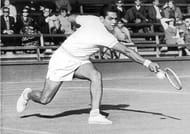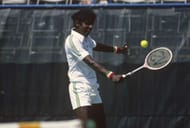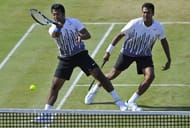India is a country of more than a billion people, approximately one-sixth of all humanity lives in the subcontinent. If sporting achievement was distributed equally based on population, Indian sportsmen and sportswomen would receive two out of every dozen trophies on offer.
But that isn’t how competitions decide their winners. Victory must be won; it isn’t handed out like meal vouchers. In spite of having some of the most passionate sports fans in the world, very few medals adorn Indian cabinets. With the exception of cricket in the past thirty-five years, and hockey before that, no other sport has given the fans much reason to cheer.
Indian tennis at the Davis Cup, in particular, has written a tale with very few moments of celebration. With four singles rubbers in every tie, a squad needs strong singles players to guarantee victory and the Indian bench has usually been depleted in that regard.
A promising beginning
It may surprise many to learn that India was a competent challenger at the Davis Cup in the decades post independence. Led by Ramanathan Krishnan, who reached the Wimbledon semi-finals in 1960 and 1961 and was a top-ten singles player, the team reached the Inter-Zonal finals ( the equivalent of the World Group semi-finals in the current format) five times between 1955 and 1970.
Jaideep Mukerjea and Premjit Lall were his able lieutenants. The three musketeers took India to the 1966 Challenge Round, just one step away from winning the tournament, and put up a spirited display against Australia.
Mukerjea and Krishnan partnered to win the doubles and Mukerjea took Fred Stolle, a multiple Grand Slam winner, to the full distance before losing 10-8 in the final set.
The baton passed on to Vijay Amritraj, India’s next hope in the singles format, in the 1970s. Top players around the world had begun skipping the tournament and the world number one, Jimmy Connors, was usually absent from the American squad.
Playing alongside his older brother, Amritraj took advantage of a favourable draw in 1974. Thanks to his own phenomenal singles form that year, the Indians charged into the finals against South Africa.
It was perhaps the nation’s best chance to lift the trophy but India withdrew from the competition in protest against the apartheid policies pursued by the government of the African country.
A few wins and many losses
For a decade after 1975, the Indian Davis Cup record wasn’t one that filled fans with pride. They lost in the early rounds of the zonal rubbers and only stayed on the fringes of the World Group.
Amritraj was a top 20 player, winning tournaments in both singles and doubles. He reached the Wimbledon semi-finals in 1981 and chalked up victories against both John McEnroe and Bjorn Borg. Of the eleven matches he played against Jimmy Connors, he won five.
But even one decent singles player is usually not enough for Davis Cup victories. If Amritraj won his matches, his teammates lost the others. Against strong squads from USA or Australia, the Indian team was easily outplayed.
Amritraj ultimately found an able Davis Cup partner in Ramesh Krishnan, who came to the limelight in the mid-1980s. With a career-high singles ranking of 23 in 1985, Ramesh followed the footsteps of his father to become another Indian tennis legend.
Amritraj and the junior Krishnan together – with contrasting styles of play – became the two pillars of the Davis Cup squad for a couple of years. Both were capable of beating top singles players. The results spoke for themselves when they overcame the Australians in Sydney to guide India to its third Davis Cup final in 1987.
Also Read: Mahesh Bhupathi attempts to shut out false claims by Leander Paes with these screenshots
India lost to the Swedes in that final tie. Amritraj was 34 years old and as age caught up with him, his singles form dipped. Those five rubbers in Gothenburg, Sweden’s second-largest city, became India’s last tryst with the top rung of the Davis Cup till date.
The squad did cause an upset a few years later to beat France in the quarter-finals in 1993, thanks to the heroic efforts of a young Leander Paes and a dehydrated Krishnan. But that’s where the journey ended.
Lack of singles players
Paes and Mahesh Bhupathi were meant to take the reins and steer Indian tennis. In 1999, the pair reached all four Grand Slam doubles finals. Between the two of them, they hold the record for the longest winning streak in doubles in Davis Cup history.
However, their skills didn’t match up to the best players in the singles game. Paes was the world’s top-ranked singles player at the junior level but his promise and potential never materialised in professional tennis.
He pulled off a few upsets – notably against Wayne Ferreira and Goran Ivanisevic – in the Davis Cup but his highest singles rank ever was only 73. Bhupathi was much further back at 213.
Without a strong singles player, the Indian team has continued to struggle against second-tier opponents. In the past decade, Rohan Bopanna’s name has been added to the list of Indian doubles specialists but there isn’t a singles champion in sight yet.
Yuki Bhambri, another junior world number one in singles, hasn’t managed to reach the top echelons at the professional level.
If there is anything that the Indian tennis administrators must concentrate on, it is this issue. Why aren’t Indian players who do well at junior tournaments able to maintain their standards at the senior level? Zeeshan Ali, the Indian Davis Cup coach, believes the lack of financial support is to blame.
At the initial stages of their careers, players should only have to worry about the speed of their serves and not the weight of their wallets. With the popularity of tennis in India at an all-time high, fans can only hope that the next junior champion gets all the support he or she needs to become a top singles player.
Only then will the Indian squad win ties in the World Group. Only then can they dream of bringing the Davis Cup home.



